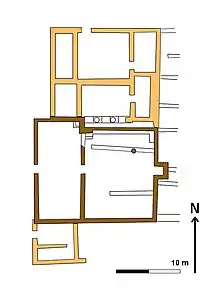| Priene Synagogue | |
|---|---|
 Plan of the Synagogue, 1904 | |
| Religion | |
| Affiliation | Judaism |
| Status | Archaeological site |
| Location | |
| Location | Priene, Turkey |
| Geographic coordinates | 37°39′30.8″N 27°17′44.4″E / 37.658556°N 27.295667°E |
| Architecture | |
| Type | Synagogue |
| Completed | 2nd century |
The Priene Synagogue is an ancient synagogue discovered by archaeologists in Priene, Turkey.
The synagogue was discovered by archaeologists Theodor Wiegand and Hans Schrader in the western residential area in 1895–98. The synagogue dates to the 2nd century CE and was built into an older Hellenistic house. It consists of a main hall with two rows of columns forming a small basilica. Only one column was still in place. However, in the 1904 excavation report they mistakenly speculated that the structure was a house church.[1] In 1928 archaeologist Eleazar Sukenik identified the building as a synagogue, pointing to a niche for the Torah Ark. He also noted the carved menorah near the niche. It is known that hundreds of thousands of Jews lived in Asia Minor in the 1st century CE. Only two confirmed synagogues have been discovered: the Sardis Synagogue and this second one in Priene.
In the summer of 2009 archeologists Nadin Burkhardt from the University of Frankfurt am Main and Mark Wilson of the Asia Minor Research Center in Izmir began an exploration of the synagogue in a dig sponsored by the Biblical Archaeology Society.[2]
See also
References
- ↑ Hans Schrader/ Theodor Wiegand: Priene. Ergebnisse der Ausgrabungen und Untersuchungen in den Jahren 1895–1898. Berlin 1904, p. 480–481. (The excavation report online
- ↑ Wilson, Mark. "Letter from the Field: An Ancient Synagogue Comes to Light". Biblical Archaeology Review. Archived from the original on 15 December 2009. Retrieved 25 November 2009.; Nadin Burkhardt, Mark Wilson, "The Late Antique Synagogue in Priene: Its History, Architecture, and Context", Gephyra 10, 2013, pp.166-196
37°39′30.8″N 27°17′44.4″E / 37.658556°N 27.295667°E